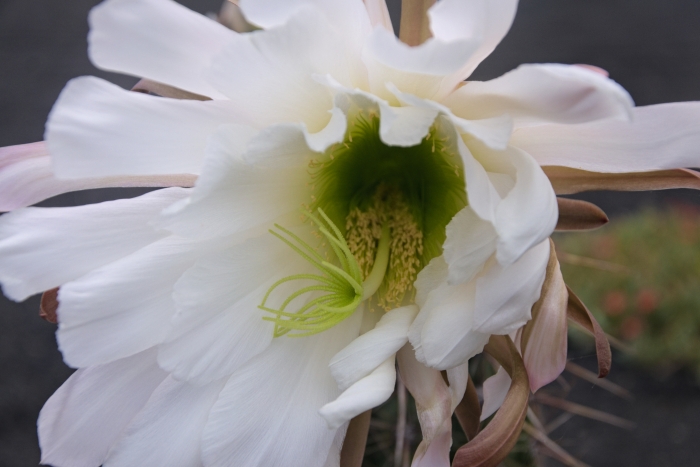Bolivian Torch Cactus
(Echinopsis lageniformis)
Bolivian Torch Cactus (Echinopsis lageniformis)
/
/

Santamarcanda
CC BY-SA 4.0
Image By:
Santamarcanda
Recorded By:
Copyright:
CC BY-SA 4.0
Copyright Notice:
Photo by: Santamarcanda | License Type: CC BY-SA 4.0 | License URL: https://creativecommons.org/licenses/by-sa/3.0 | Uploader: Santamarcanda | Publisher: Wikimedia Commons |















Estimated Native Range
Summary
Echinopsis lageniformis, commonly known as Bolivian Torch Cactus, is an evergreen succulent native to the high deserts of Bolivia and Argentina. It is a fast-growing columnar cactus that can reach 2–5 meters (6.6–16.4 ft) in height. The plant exhibits a greenish to bluish hue and typically features four to eight pronounced ribs. Spines, which can range from honey-colored to brown, are found on the nodes in groups of up to four. The Bolivian Torch Cactus blooms with large, fragrant white flowers during the summer months, which open at night and can be quite showy.
This cactus is valued for its sculptural form and is often used as a striking focal point in xeriscapes, rock gardens, and desert-themed landscapes. Its ability to tolerate drought and thrive in poor soils with minimal care makes it a popular choice for low-maintenance gardens. It requires full sun exposure and very little water, with a preference for well-draining soils. While generally pest-resistant, it can be susceptible to root rot if overwatered or planted in poorly draining soils. It is also important to protect it from frost, as it is not cold-hardy.CC BY-SA 4.0
This cactus is valued for its sculptural form and is often used as a striking focal point in xeriscapes, rock gardens, and desert-themed landscapes. Its ability to tolerate drought and thrive in poor soils with minimal care makes it a popular choice for low-maintenance gardens. It requires full sun exposure and very little water, with a preference for well-draining soils. While generally pest-resistant, it can be susceptible to root rot if overwatered or planted in poorly draining soils. It is also important to protect it from frost, as it is not cold-hardy.CC BY-SA 4.0
Plant Description
- Plant Type: Succulent
- Height: 9-15 feet
- Width: 0.18-0.3 feet
- Growth Rate: Moderate
- Flower Color: White
- Flowering Season: Summer
- Leaf Retention: Evergreen
Growth Requirements
- Sun: Full Sun
- Water: Very Low, Low
- Drainage: Fast
Common Uses
Drought Tolerant, Low Maintenance, Showy Flowers
Natural Habitat
Native to the high deserts of Bolivia and Argentina
Other Names
Common Names:
Scientific Names: , Echinopsis lageniformis, Trichocereus bridgesii, Trichocereus scopulicola, Trichocereus riomizquensis, Echinopsis scopulicola, Trichocereus crassicostatus, Cereus bridgesii, Cereus bridgesii f. brevispinus, Cereus bridgesii f. lageniformis
GBIF Accepted Name: Echinopsis lageniformis (C.F.Först.) Friedrich & G.D.Rowley